All resources were mobilized in the
field of fine arts in Turkey as of the first years of the Republic,
towards a more dynamic and progressive production of art by also
benefiting from a backlogue of the past. The modernization that
accelerated under the leadership of Ataturk, and with the following of
the thought and art movements in Europe in a conscious and sensitive
manner, paved the way for the creation of the cul- ture and art of the
new Republic. In fact, today it is observed that a "Modern
Turkish Art" language has been formed which represents Turkey at
an international level, in which the individual styles are prominent
and in which regional motifs and subjects gain importance. Within
"Modern Turkish Art" based on an East-West synthesis the
cultural values of the "past and future" also exist by being
blended together.
Painting
|
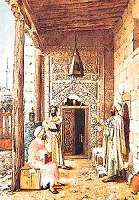
"At the gate of Karaman Medresse"
by Osman Hamdi Bey
|
Painting in the
western sense started to develop in Turkey in the nineteenth
century. Artists such as Namik Ismail, Ibrahim Calli, Avni Lifij,
Feyheman Duran and Hikmet Onat, who had their art education in
Europe in the 1910s, became impressionists. These artists, who
are known as the 1914 Generation , influenced the development of
painting in the early Republic Period. Extensive research
carried out by Public Centers (Halkevleri) on Anatolian peoples'
art and culture in the 1930s influenced many artists and caused
them to deal with the issues raised in the wake of the findings
of the research.
|
In this period, the D Group,
established by Zeki Faik Izer, Nurullah Berk, Elif Naci, Cemal Tollu,
Abidin Dino and sculptor Zuhtu Muridoglu, ignored the impressionist
tendencies and set out to create a joint language, and sought to
achieve a synthesis between certain elements of traditional Turkish
art and the ideas of the new art movements in Europe, between local
color and western techniques and between domestic "soul" and
the universal artistic ideals
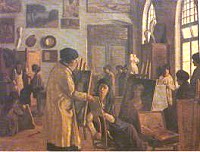
Within the art and culture development
program, which gained momentum after the 1930s, the Academy of Fine
Arts in Istanbul, which was called Sanayi-i Nefise Mektebi until 1936,
was restructured. It was taken under the structure of the Ministry of
National Education. A French artist, Leopold Levy, was appointed as
the chairman of the painting department between 1949 and 1950. Levy's
students founded a group aptly called the Yeniler Grubu (The New Group)
which was the most important group in the field of painting after the
D Group and which experimented with new styles and new techniques. The
members of this group, who continued exhibitions until 1955, were
focused on social issues in the beginning, but later distanced
themselves from the social-realistic manner of expression.
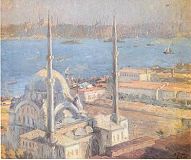
In the 1950s, when the art movements
were followed more closely, the first abstract painters emerged in
Turkey. Among these are Adnan Coker, Lutfu Gunay, Semsi Arel, Abidin
Elderoglu and Sabri Berkel who tried to give a traditional and local
touch to abstract forms by using calligraphy. Neset Gunal's paintings
on social issues, the miniature-like paintings of Devrim Erbil, Cihat
Burak's paintings which have traces from folk art, the animal figures
and Anatolian landscapes of Orhan Peker which he painted with staining
techniques, are all examples of the diversity of figurative tendencies
in the 1960s and the 1970s. By the 1970s, many artists managed to
reach some synthesis between the competing tendencies such as abstract-figurative
and universal-domestic. Meanwhile pioneering and experimental works
were supported by the annual exhibition "New Tendencies"
held within the framework of the Istanbul Art Festival, which was
first organized in 1977. Since 1980, conceptual art works are also
common along with the traditional paintings on canvas.
Miniatures
from the Topkapi Museum
H.
Avni Lifij
Sevket
Arman
Avni
Oztopcu
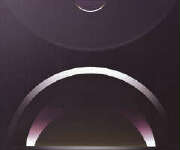
Sculpture
During the period of drawing nearer to
the West in the cultural sense, that started in the final years of the
Ottoman period, there was a revival in the field of sculpture as there
was in the other fields of art. The activities were also continued in
the Republic period to develop the art of sculpture. Series of
archaeological excavations, called "National Excavations",
were made in order to unearth the sculptural heritage of former
civilizations. Foreign masters in the field who were imported,
instructed young talents, and successful students were sent abroad for
education. In 1937, German sculptor Rudolf Belling was appointed the
chairman of the Department of Sculpture at the State Academy of Fine
Arts. Belling who served as a professor at the Academy until 1954
trained many students and continued to produce sculptures. He is the
sculptor of the Inonu monuments at the Istanbul Taslik Park and on the
campus of the Ankara University's Faculty of Agriculture. One of the
most important sculpture exhibitions in Turkey was also realized by
Belling at the Taskisla building of the Istanbul Technical University.
The first period in
this field of art, which lasted until the 1950s, in which
monuments and sculptures of Ataturk were given priority, was
dominated by foreign masters such as Krippel, Canonica, Hanak,
Thorak and Belling. However, Turkish sculptors had important
successes in the monument competitions which started to be
organized as of 1937. For instance, Ali Hadi Bara won the first
prize and Zuhtu Muridoglu was placed second in the design
competition
|
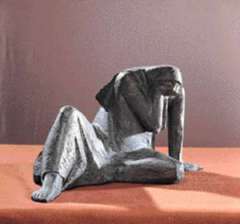
"Yalnızlık" (Loneliness) by
Huseyin Gezer
|
for the Erzurum Monument , and Nejat
Sirel won the first prize in the competition for the Manisa Monument
in which foreign sculptors had also taken part.
Many of the sculptors who started their
professional life in the 1950s, such as Hakki Atamulu, Yavuz Gorey,
Kamil Sonad, Ilhan Koman, Huseyin Gezer and Turgut Pura, were the
students of Belling. Even those sculptors whose works are mainly
figurative have also experimented with figurative-abstract works.
However, some of them, namely Ilhan Koman, Sadi Calik and Turgut Pura,
produced mainly abstract sculptures. Among them, Ilhan Koman held many
exhibitions abroad and won prizes in numerous competitions.
Hadi Bara and Zuhtu Muridoglu
influenced the Academy's Department of Sculpture after the 1950s.
Abstractionist approaches and the use of various contemporary tools
and techniques were characteristics of this period. Sculptors such as
Tamer Basoglu, Kuzgun Acar, Gurdal Duyar and Namik Denizhan are the
main representatives of this school. Kuzgun Acar, who won the first
prize at the Paris Youth Biennial in 1961, produced some very
interesting abstract sculptures. For instance, Kuslar (The Birds), an
iron relief in front of the Istanbul Manifaturacilar Carsisi (Istanbul
Textiles Bazaar), is his work. Mehmet Aksoy who brought new dimensions
to figurative sculpture, Ferit Ozsen who produced abstract works with
metal and stone material, Saim Bugay and Hayri Karay who attracted
attention with their woodworks and Metin Haseki, are some of the other
noteworthy contemporary sculptors.
Photography
Photography, which has a history dating
back to the 1850s, experienced a rapid development during the early
decades of the Republic Period. New techniques developed in the West
were imported and the press started using photographs extensively.
Turkish photographers of the period started to take pictures of the
daily life of people, towns and cities and historical buildings in
Turkey. Landscape photography also developed. The first photography
competition was organized in 1932. Meanwhile courses in photography
were included in the curriculum of schools and photographers'
associations were established in the 1930s.
|
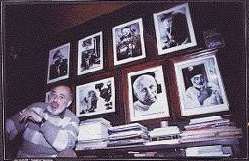
Photographer Ara Güler
|
Cemal Isiksel,
Nurettin Erkilic, Selahattin Giz, Limasollu Naci, Sinasi Barutcu,
Ihsan Erkilic and Baha Gelenbevi are the first important
photographers of the Early Republic Period. The first seeds of
artistic photography were sown by the generation of artists who
were raised in the 1950s.
|
One of the most important
photographers of this generation is Ara Guler, who looks at local
subjects from the point of view of a contemporary artist and with
remarkable skill. Recognized as a distinguished artist not only in
Turkey but throughout the world, Ara Guler, who is regarded by some
critics as being among the best ten photographers in the world, has also
taken pictures for various world-famous photography magazines. Ozan
Sagdic, a press photographer who has also taken promotional photographs,
produced original works illustrating various parts of Turkey. Gultekin
Cizgen, who made extensive use of localmotifs, attracted attention with
his graphic works and his photographs dealing with social subjects.
Sahin Kaygun, who exhibited a rather unique approach to photography with
his incessant search for originality, used fantastic, symbolic and
graphic styles; exhibited his polaroid works and became the pioneer of
this technique in Turkey. Atilla Torunoglu in black and white
photographs, Mustafa Kapkin in studio-tricks, Halim Kulaksiz in color
pictures, Reha Guney in architectural photography, Fikret Otyam in
journalism and Sami Guner in tourism photography, are among the other
noteworthy photo-graphers in contemporary Turkey. Ersin Alok, Semsi
Guner, Sabit Kalfagil, Isa Celik, Sakir Eczacibasi, Cengiz Karliova,
Ibrahim Demirel, Halim Kulaksiz, Mehmet Bayhan, Cerkes Karadag, Nuri
Bilge Ceylan, Ramazan Ozturk and Coskun Aral have also attracted
attention and acclaim with their works.
The oldest and best-established
photography organization in Turkey is IFSAK (Istanbul Photographers and
Cinema Amateurs' Association). Similar associations such as AFSAD-Ankara,
AFAD-Adana, Foto Forum-Trabzon, and KASK-Kocaeli also have influential
activities.
The
Art of Cartoon
In Turkey, the art of
cartoon started in the second half of 19th century and has developed in
parallel to liveliness in publication life. With the publication of the
first humor magazine, Diyojen , cartoon reached an independent milieu of
publication. The cartoons of the period show, generally, the
characteristic of drawings that emphasize the humorous side of anecdotes
and poems, and of those drawings that ornament them.
With the establishment of
the Republic, Cemal Nadir Guler and Ramiz Gokce, two important artists
of Turkish cartoons, contributed, with their drawings, to the efforts of
establishing a new state and of creating a Republican society. In the
same period, Akbaba (Vulture), the most long-lived humor magazine of the
Republican period, published by Yusuf Ziya Ortac, and in which various
tendencies were displayed, left its mark on the period, in view of its
cadre of strong authors and cartoonists.
Along with the new freedoms
due to the transition to multi-party order in the aftermath of World War
II, a transformation was experienced in hu- mor. Marko Pasa, which was
published by Saba- hattin Ali and Aziz Nesin and whose cartoonist was
Mustafa Uykusuz, was the most important humor magazine of the period.
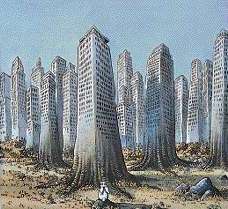
Selcuk Demirel, 34X34.7, 1994
|
The Generation of the
1950's that brought a new concept to the art of cartoon, developed
a car- toon humor not based on writing and word. This group,
forming a new and contemporary aesthetics of cartoon art, analyzed
the structural problems of society in depth and drew accordingly.
They spread their new concept of cartoon, not only by drawing, but
also by collective exhibitions, articles, seminars and by such
humor magazines as 41 Bucuk (41 and a half), Tef (Tambourine),
Dolmus (Taxi) and Tas-Karikatur (Stone Cartoon). |
The famous cartoonists of the
period are Turhan Selcuk, Nehar Tublek, Ali Ulvi Ersoy, Eflatun Nuri Koc,
Selma Emiroglu, Semih Balcioglu, Bedri Koraman, Altan Erbulak, Mustafa
Eremektar, Sinan Bicakcioglu, Ferruh Dogan, Tonguc Yasar, Suat Yalaz,
Yalcin Cetin and Oguz Aral. Cafer Zorlu, Zeki Beyner, Tan Oral, Nezih
Danyal, Ercan Akyol, Erdogan Bozok, Orhan Ozdemir and Selcuk Demirel who
were brought up between 1960 and 1970, continued the cartoon concept of
the Generation of the 1950's by their original contributions.
The Cartoonists' Society,
which was established in 1970, contributed to the development of a
generation of young cartoonists through the International Cartoon Contest
of Nasred- din Hodja, collective exhibitions and catalogs. Young
cartoonists gathered in the weekly humor magazine, Girgir (Fun), under the
management of Oguz Aral, developed, with the contributions of Tekin Aral,
a popular humor, based on words, ridiculing mainly persons and events
created by distorted urbanization.
The change of values that came
about in society after 1980, is being criticized and interpreted in a
manner that combine word and writing with their drawings by Ismail Gulgec,
Kamil Masaraci, Salih Memecan, Semih Poroy, Behic Ak, Piyale Madra, Hasan
Kacan, Ergun Gunduz, Latif Demirci, Haslet Soyoz and Kemal Gokhan Gurses.
Turkish cartoon has a
prominent place in world cartoon, thanks both to the international success
of Turkish cartoonists and their exhibitions abroad, and to the
international activities on the subject of cartoon art held in the country.
The International Cartoon Contest of Nasreddin Hodja held by the
Cartoonists' Society, the Hurriyet International Cartoon Contest held by
Aydin Dogan Foundation, and the Ankara International Cartoon Festival held
by the Cartoon Founda- tion, are some of the cartoon activities known
worldwide.
Architecture
The Turks produced
masterpieces of architecture during the Seljuk and Ottoman periods.
The monumental buildings created by Turkish architects since the
eleventh century have a distinguished place in the heritage of
world architecture. The Selimiye and the Suleymaniye Mosques built
by Mimar (Architect) Sinan, who is the symbol of Ottoman
architecture, are masterworks reflecting the degree of maturity
which the Ottoman architecture had reached in the sixteenth and
seventeenth centuries in dealing with space and mass compositions.
In fact, classical Ottoman style puts forth universal leaps and
values.
Mimar
Sinan 1489-1588
 |
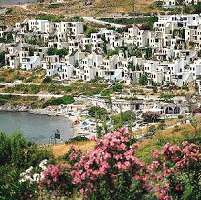
It is possible to
see the most beautiful examples of the white colored Mediterranean
architecture along the coastal regions in Turkey.
|
The Early Republic Period
Turkish architecture which was dominated by the First National
Architectural Move- ment until 1930, developed as a continuation of
Ottoman architecture. Architects of this period erected public buildings
to serve the needs of the major Anatolian cities in the wake of the
Turkish War of Independence. These architects who seem to have borrowed
certain elements of Seljuk and Ottoman architecture, and who were led by
Kemaleddin Bey and Vedat Tek, assigned special importance to facades
which they decorated, sometimes elaborately, with stone carvings and
ceramic tiles. The public buildings, some of which are standing today,
reflect the pecularities of the First National Movement. After the
1930s, foreign architects began to dominate architectural activities.
They brought functional designs and an austere look to buildings. Flat
roofs were preferred; the facades were bereft of ornaments; large
windows were used and almost invariably, buildings were erected in a
design of which simplicity and function were given top priority. Most of
these foreign architects also worked as instructors and professors in
schools of architecture and thus trained a new generation of architects.
Meanwhile the Turkish architects of the 1930s mostly followed these
imported masters.
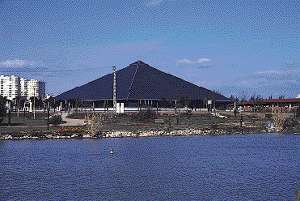
The Glass Pyramid Congress
Center
|
The Second National
Architectural Movement, between 1940-1950, unlike the first,
focused on some of the essential elements of design utilized in
the civilian buildings of traditional Turkish architecture rather
than merely on ornamental elements.
|
The architects of this
"movement" used structural elements such as eaves, wooden
latticework, brackets and windows and carefully searched for a balance
between the architectural ideas and elements they utilized. A meticulous
workmanship in their works attracts attention. They were also careful
about selecting the proper construction material to fit regional
conditions. This facilitated and provided opportunities for the
development of a local construction materials industry. The Macka Sark
Kahvesi (Cafe) and various waterfront mansions on the Bosphorus are
among the distinguished works of Sedat Hakki Eldem, one of the most
important architects of the period. Emin Onat who is another noteworthy
architect of this period produced works both with a regional and
national perception. His Anitkabir (Ataturk's Mausoleum) project in
Ankara, which he designed together with Orhan Arda, is the most
important monumental masterpiece of the period.
In the early 1950s, the
influence of the Second National Architectural Movement rapidly faded
and the influence of Western architecture intensified. This period,
which lasted until the 1960s, and during which an exploration process in
education, organization, design and application was predominant, can be
regarded as a period of preparation for the emergence of contemporary
Turkish architecture. Since the 1960s Turkish architects have been
involved in an unending exploration of concepts, scientific principles
and aesthetic values in architectural design. This resulted in the
emergence of a myriad of approaches and tendencies and led to a dynamic
and productive pluralism in architecture. No single vision and no single
movement dominates the contemporary Turkish architectural scene. While
making contributions emanating from their own creative resources, and
from their unique personal or stylistic tendencies, contemporary Turkish
architects have tried almost every architectural approach, from the use
of fantastic and/or irrational forms to expressionist approaches, from
creating monumental symbols to the utilization of traditional elements
and from an arabesque search to postmodernist designs.
|